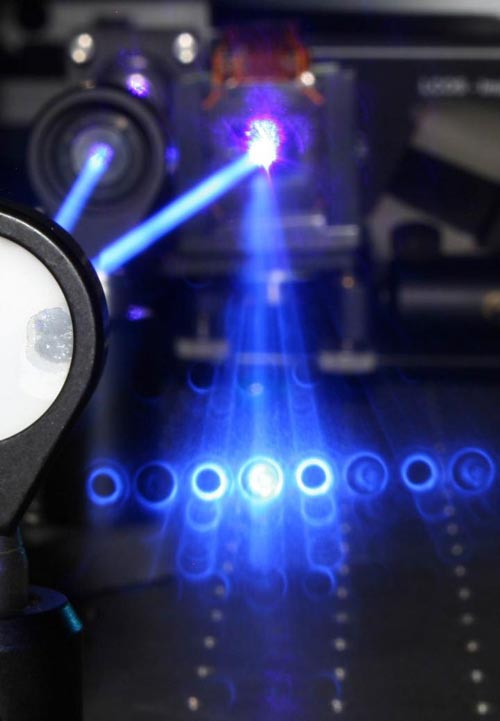Three 'twisted' photons in 3 dimensions

Long-exposure photo of laser beams with a twisted wavefront. The beams have holes in the middle due to destructive interference at the center of the twists. Copyright: Faculty of Physics, University of Vienna
Researchers at the Institute of Quantum Optics and Quantum Information, the University of Vienna, and the Universitat Autonoma de Barcelona have achieved a new milestone in quantum physics: they were able to entangle three particles of light in a high-dimensional quantum property related to the 'twist' of their wavefront structure. The results from their experiment appear in the journal Nature Photonics.
Entanglement is a counterintuitive property of quantum physics that has long puzzled scientists and philosophers alike. Entangled quanta of light seem to exert an influence on each other, irrespective of how much distance is between them. Consider for example a metaphorical quantum ice dancer, who has the uncanny ability to pirouette both clockwise and counter-clockwise simultaneously.
A pair of entangled ice-dancers whirling away from each other would then have perfectly correlated directions of rotation: If the first dancer twirls clockwise then so does her partner, even if skating in ice rinks on two different continents.
“The entangled photons in our experiment can be illustrated by not two, but three such ice dancers, dancing a perfectly synchronized quantum mechanical ballet,” explains Mehul Malik, the first author of the paper.
“Their dance is also a bit more complex, with two of the dancers performing yet another correlated movement in addition to pirouetting. This type of asymmetric quantum entanglement has been predicted before on paper, but we are the first to actually create it in the lab.”
From fundamentals to applications: Layered quantum cryptography
The scientists created their three-photon entangled state by using yet another quantum mechanical trick: they combined two pairs of high-dimensionally entangled photons in such a manner that it became impossible to ascertain where a particular photon came from. Besides serving as a test bed for studying many fundamental concepts in quantum mechanics, multi-photon entangled states such as these have applications ranging from quantum computing to quantum encryption.
Along these lines, the authors of this study have developed a new type of quantum cryptographic protocol using their state that allows different layers of information to be shared asymmetrically among multiple parties with unconditional security.
“The experiment opens the door for a future quantum Internet with more than two partners and it allows them to communicate more than one bit per photon,” says Anton Zeilinger. Many technical challenges remain before such a quantum communication protocol becomes a practical reality. However, given the rapid progress in quantum technologies today, it is only a matter of time before this type of entanglement finds a place in the quantum networks of the future.
###
This research was supported by the European Commission, the European Research Council (ERC) and the Austrian Science Fund (FWF).
Publication in Nature Photonics
Multi-Photon Entanglement in High Dimensions: Mehul Malik, Manuel Erhard, Marcus Huber, Mario Krenn, Robert Fickler, Anton Zeilinger. Nature Photonics, 2016 http://dx.
Preprint: http://arxiv.
Further information: http://www.
Media Contact
All latest news from the category: Physics and Astronomy
This area deals with the fundamental laws and building blocks of nature and how they interact, the properties and the behavior of matter, and research into space and time and their structures.
innovations-report provides in-depth reports and articles on subjects such as astrophysics, laser technologies, nuclear, quantum, particle and solid-state physics, nanotechnologies, planetary research and findings (Mars, Venus) and developments related to the Hubble Telescope.
Newest articles

NASA: Mystery of life’s handedness deepens
The mystery of why life uses molecules with specific orientations has deepened with a NASA-funded discovery that RNA — a key molecule thought to have potentially held the instructions for…

What are the effects of historic lithium mining on water quality?
Study reveals low levels of common contaminants but high levels of other elements in waters associated with an abandoned lithium mine. Lithium ore and mining waste from a historic lithium…

Quantum-inspired design boosts efficiency of heat-to-electricity conversion
Rice engineers take unconventional route to improving thermophotovoltaic systems. Researchers at Rice University have found a new way to improve a key element of thermophotovoltaic (TPV) systems, which convert heat…



